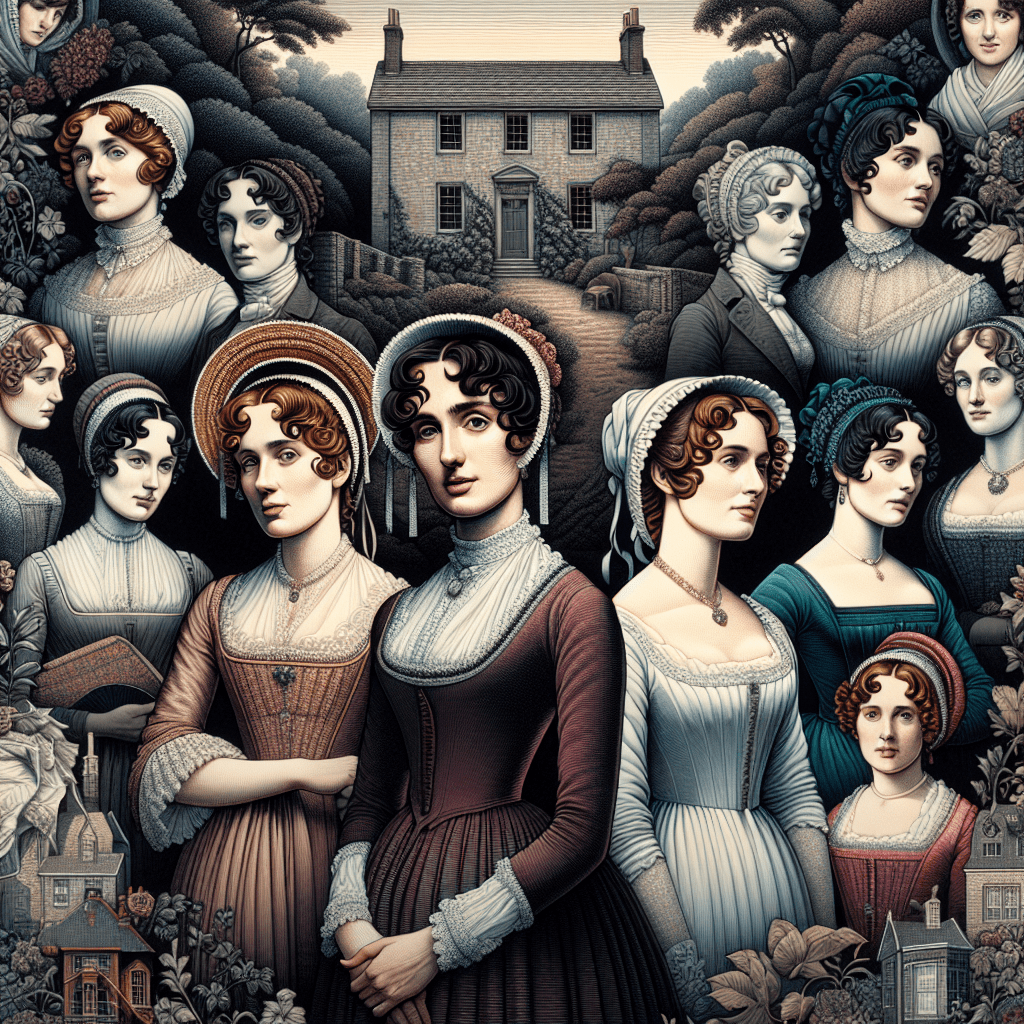-
Innehållsförteckning
- Cast Summary av Förnuft och känsla
- Centrala teman i Förnuft och känsla
- Karaktärsanalys av Elinor Dashwood
- Karaktärsanalys av Marianne Dashwood
- Den sociala klassens roll i "Sense and Sensibility
- Romantiska relationer i Förnuft och känsla
- Bearbetningar av Förnuft och känsla: Ett karaktärsperspektiv
- FRÅGOR OCH SVAR
"Utforskar kärlek, plikt och balansen mellan förnuft och känslor i Austens tidlösa berättelse om systrarna Dashwood."
**Introduktion till Förnuft och känsla: Cast Summary, Teman & Karaktärer**
"Sense and Sensibility", en roman av Jane Austen, utforskar livet och de romantiska förvecklingarna hos systrarna Dashwood, Elinor och Marianne, när de navigerar mellan samhällets förväntningar och personliga önskningar i England i början av 1800-talet. Berättelsen är rik på en mängd olika karaktärer, som alla förkroppsligar olika egenskaper som återspeglar berättelsens centrala teman, inklusive kontrasten mellan förnuft och känslor, vikten av social status och komplexiteten i kärlek och relationer. Genom samspelet mellan och utvecklingen av karaktärer som Edward Ferrars, överste Brandon och Willoughby fördjupar sig Austen i det mänskliga beteendets intrikata sidor och de samhälleliga påtryckningar som formar individuella val. Den här sammanfattningen ger en översikt över huvudpersonerna, deras relationer och de övergripande teman som definierar denna tidlösa klassiker.
Cast Summary av Förnuft och känsla
I "Förnuft och känsla", Jane Austens älskade roman, ger ensemblen liv åt en rik väv av karaktärer som förkroppsligar temana förnuft och känsla. I centrum för berättelsen står systrarna Dashwood, Elinor och Marianne, som representerar olika förhållningssätt till kärleken och livet. Elinor, den äldre systern, kännetecknas av sin pliktkänsla och rationalitet. Hon framställs som en förebild för självbehärskning och praktiska lösningar och undertrycker ofta sina egna känslor till förmån för familjen och samhällets förväntningar. Marianne däremot är förkroppsligandet av passion och spontanitet. Hennes romantiska ideal och känslomässiga öppenhet får henne att uppleva kärleken intensivt, men hennes brist på behärskning leder ofta till hjärtesorg.
Som stöd för systrarna Dashwood finns en mängd karaktärer som berikar berättelsen. Deras mor, mrs Dashwood, är änka och strävar efter att försörja sina döttrar efter makens död. Hennes karaktär speglar den kamp som kvinnor på hennes tid stod inför, när hon navigerar mellan samhällets begränsningar samtidigt som hon försöker säkra en framtid för sin familj. Systrarna Dashwoods halvbror, John Dashwood, är en figur som präglas av moralisk tvetydighet. Trots att han till en början lovar att stödja sin mor och sina systrar, ger han till slut efter för sin rika fru Fannys inflytande, vilket avslöjar komplexiteten i familjelojalitet och själviskhet.
Under berättelsens gång stöter systrarna på olika friare som ytterligare illustrerar temat förnuft och känslighet. Edward Ferrars, Elinors kärleksintresse, är en man med integritet och vänlighet, men han är bunden av sin egen pliktkänsla, vilket komplicerar hans förhållande till Elinor. Hans karaktär fungerar som en motvikt till Willoughby, Mariannes första romantiska intresse, som är charmig och karismatisk men som i slutändan avslöjar en mer självisk natur. Willoughbys karaktärsbåge belyser farorna med okontrollerade känslor och konsekvenserna av att prioritera passion framför förnuft.
En annan viktig karaktär är överste Brandon, som representerar en mer mogen och stabil form av kärlek. Hans tysta styrka och orubbliga stöd för Marianne står i skarp kontrast till Willoughbys impulsivitet. Allt eftersom berättelsen fortskrider blir överste Brandons ståndaktighet en källa till tröst för Marianne, vilket illustrerar temat tillväxt och kärlekens utveckling. Interaktionen mellan dessa karaktärer driver inte bara handlingen framåt utan tjänar också till att utforska de bredare samhälleliga frågorna om klass, kön och moral.
Dessutom bidrar närvaron av bipersoner, som Lucy Steele, till att skapa fler lager av intriger och konflikter. Lucys sluga och manipulativa natur exemplifierar de mörkare aspekterna av mänskliga relationer, eftersom hon försöker säkra sin egen framtid på bekostnad av andras. Hennes karaktär fungerar som en påminnelse om de samhälleliga påtryckningar som ofta dikterar personliga val, vilket ytterligare betonar romanens utforskning av spänningen mellan individuella önskningar och sociala förväntningar.
Sammanfattningsvis är rollbesättningen i "Förnuft och känsla" en viktig del av romanens utforskande av dess centrala teman. Varje karaktär, från systrarna Dashwood till deras olika friare och bekanta, bidrar till en nyanserad skildring av kärlek, plikt och kampen mellan förnuft och känsla. Genom deras interaktioner och personliga resor skapar Austen en berättelse som väcker genklang hos läsarna och inbjuder dem att reflektera över komplexiteten i mänskliga relationer och de samhälleliga normer som formar dem. Samspelet mellan dessa karaktärer berikar inte bara berättelsen utan understryker också den tidlösa relevansen i Austens insikter om människans villkor.
Centrala teman i Förnuft och känsla
I Jane Austens "Förnuft och känsla" är utforskandet av viktiga teman intrikat invävt i berättelsen, vilket ger en rik väv som speglar komplexiteten i mänskliga relationer och samhälleliga förväntningar. Ett av de mest framträdande temana är kontrasten mellan förnuft och känsla, som förkroppsligas i de två huvudpersonerna Elinor och Marianne Dashwood. Elinor representerar förnuftet, som kännetecknas av hennes rationalitet, lugn och följsamhet till sociala konventioner. Marianne däremot förkroppsligar känsligheten, som kännetecknas av känslomässigt djup, impulsivitet och romantiska ideal. Denna dikotomi belyser inte bara de olika förhållningssätten till kärleken och livet utan fungerar också som en kommentar till nödvändigheten av balans mellan förnuft och känsla i personliga relationer.
Dessutom är temat kärlek och dess olika yttringar centralt i berättelsen. Austen fördjupar sig i romantiska relationers komplexitet och illustrerar hur kärlek kan vara både en källa till glädje och en orsak till lidande. De kontrasterande relationerna mellan Elinor och Edward Ferrars och Marianne och John Willoughby exemplifierar detta tema. Elinors kärlek grundar sig på ömsesidig respekt och förståelse, medan Mariannes passionerade förhållande till Willoughby leder till ett krossat hjärta. Genom dessa relationer kritiserar Austen den samhälleliga press som dikterar romantiska val och betonar vikten av äkta tillgivenhet framför ytlig attraktion.
Ett annat viktigt tema är den sociala klassens och den ekonomiska trygghetens roll i äktenskapet. Systrarna Dashwood ställs inför den hårda verkligheten med sin ekonomiska situation efter faderns död, vilket understryker kvinnors osäkra sociala ställning i början av 1800-talet. Austen illustrerar hur ekonomiska överväganden ofta överskuggar romantiska känslor, vilket framgår av Lucy Steeles karaktär, som inte följer Edward Ferrars av kärlek utan för hans potentiella ekonomiska stabilitet. Detta tema väcker frågor om äktenskapets natur och i vilken utsträckning kärlek kan blomstra i ett samhälle som prioriterar rikedom och status.
Dessutom utforskas temat familj och systerskap på ett intrikat sätt i hela romanen. Bandet mellan Elinor och Marianne fungerar som en grund för deras motståndskraft i motgångar. Deras olika personligheter kompletterar varandra och gör det möjligt för dem att navigera genom de utmaningar de möter. Det stöd de ger varandra belyser vikten av familjerelationer i en värld där yttre omständigheter kan vara oförlåtande. Detta tema väcker genklang hos läsarna, eftersom det understryker idén att kärlek och lojalitet inom familjer kan ge tröst och styrka under svåra tider.
Dessutom är temat samhälleliga förväntningar och de begränsningar som de medför för individuella önskningar vanligt förekommande i berättelsen. Karaktärer som Mrs Jennings och Lady Middleton förkroppsligar de samhälleliga normer som dikterar beteende och relationer. Austen kritiserar dessa förväntningar och visar hur de kan kväva den personliga lyckan och leda till missförstånd. Spänningen mellan individuella önskningar och samhällets påtryckningar är ett återkommande motiv som får läsarna att reflektera över hur sociala konventioner påverkar den personliga tillfredsställelsen.
Sammanfattningsvis presenterar "Förnuft och känsla" en mångfacetterad utforskning av teman som väcker genklang hos läsare över generationer. Med utgångspunkt i förnuft och känsla, kärlek, social klass, familj och samhälleliga förväntningar skapar Austen en berättelse som inte bara underhåller utan också väcker eftertanke och reflektion kring de mänskliga relationernas komplexitet. Den bestående relevansen av dessa teman talar för den tidlösa karaktären av Austens verk och inbjuder läsarna att engagera sig i livets och kärlekens komplexitet i sina egna sammanhang.
Karaktärsanalys av Elinor Dashwood
Elinor Dashwood, den äldre av de två Dashwood-systrarna i Jane Austens "Förnuft och känsla", är en central karaktär vars egenskaper och beslut har stor betydelse för berättelsen. Som förkroppsligandet av förnuft och återhållsamhet står Elinor i skarp kontrast till sin yngre syster Marianne, som representerar känslor och spontanitet. Denna dikotomi mellan de två systrarna driver inte bara handlingen framåt utan sammanfattar också romanens bredare teman, särskilt balansen mellan förnuft och känslighet.
Elinors karaktär präglas av en stark plikt- och ansvarskänsla, inte minst gentemot familjen. Efter faderns död tar hon på sig rollen som familjens känslomässiga ankare och strävar efter att upprätthålla stabilitet trots ekonomisk osäkerhet och sociala omvälvningar. Hennes pragmatiska inställning till livet visar sig i hennes förmåga att navigera i de nya omständigheterna med elegans och lugn. Medan Marianne ofta dukar under för förtvivlan och impulsivt beteende, förblir Elinor orubblig och visar prov på en anmärkningsvärd förmåga till självbehärskning. Denna egenskap visar inte bara på hennes mognad utan gör henne också till en förebild för rationalitet i en värld fylld av känslomässig oro.
Elinors interaktion med andra karaktärer avslöjar dessutom hennes djup och komplexitet. Hennes förhållande till Edward Ferrars, som hon älskar stillsamt och orubbligt, visar på hennes förmåga att balansera sina känslor med samhällets förväntningar. Trots sin djupa tillgivenhet för Edward avstår hon från att uttrycka sina känslor öppet och följer därmed sin tids sociala konventioner. Denna återhållsamhet beror inte på brist på passion utan snarare på en djup förståelse för de konsekvenser som otyglade känslor kan medföra. Elinors förmåga att dölja sina känslor, även när hon möter motgångar, understryker hennes karaktärsstyrka och belyser temat inre kontra yttre konflikt.
Förutom hennes romantiska förvecklingar belyser Elinors samspel med sin familj hennes karaktär ytterligare. Hon fungerar ofta som en medlare mellan Marianne och deras mor och vägleder dem genom deras känslomässiga strider med en sans som är både beundransvärd och nödvändig. Hennes ansträngningar att skydda Marianne från den hårda verkligheten, samtidigt som hon uppmuntrar henne till ett mer förnuftigt förhållningssätt till livet, speglar hennes djupt rotade kärlek till sin syster. Denna skyddsinstinkt är ett bevis på hennes lojalitet och engagemang för familjen och förstärker idén om att personlig uppoffring ofta är ett kännetecken på sann styrka.
Elinors karaktär fungerar också som en kritik av de samhällsnormer som rådde på Austens tid. Samtidigt som hon förkroppsligar dygderna rationalitet och lugn, avslöjar hennes kamp de begränsningar som lades på kvinnor i början av 1800-talet. Hennes oförmåga att öppet uttrycka sina känslor för Edward på grund av samhällets begränsningar belyser spänningen mellan individuella önskningar och sociala förväntningar. Denna konflikt är central i romanen, eftersom den väcker frågor om de roller som kvinnor förväntades spela och de uppoffringar de gjorde i anständighetens namn.
Sammanfattningsvis framstår Elinor Dashwood som en komplex och övertygande karaktär vars förnuft utgör en motvikt till den känslighet som Marianne representerar. Genom sina handlingar och relationer navigerar Elinor genom utmaningarna i sin omgivning med en blandning av styrka, lojalitet och återhållsamhet. Hennes resa speglar inte bara den personliga kamp som kvinnor under hennes tid fick utkämpa, utan inbjuder också läsarna att fundera över de vidare konsekvenserna av att balansera känslor med förnuft i sina egna liv. I slutändan tjänar Elinors karaktär som en påminnelse om den bestående relevansen av Austens utforskning av mänskliga relationer och samhälleliga förväntningar.
Karaktärsanalys av Marianne Dashwood
Marianne Dashwood, en av huvudpersonerna i Jane Austens "Förnuft och känsla", förkroppsligar essensen av romantisk idealism och känslomässig glöd. Som andra dotter till Mr och Mrs Dashwood kännetecknas Marianne av sin passionerade natur och sin djupa uppskattning för skönhet och konst. Redan från början skildras hon som en ung kvinna som inte är rädd för att uttrycka sina känslor, ofta till och med på ett hänsynslöst sätt. Denna känslomässiga intensitet skiljer henne från hennes mer reserverade syster, Elinor, och fungerar som en fokuspunkt för romanens utforskning av kontrasterande förhållningssätt till kärlek och liv.
Mariannes karaktär är intimt förknippad med hennes kärlek till poesi och musik, som speglar hennes inre värld och hennes längtan efter ett liv fyllt av romantik och äventyr. Hennes beundran för poeter som Byron och hennes skicklighet vid pianot understryker hennes känslighet och konstnärliga temperament. Denna konstnärliga läggning formar inte bara hennes identitet utan påverkar också hennes relationer, i synnerhet med Willoughby, en man som till en början verkar dela hennes passionerade livssyn. Deras relation är omedelbar och intensiv och präglas av en ömsesidig uppskattning av skönhet och ett gemensamt förakt för samhällets konventioner. Men under berättelsens gång utmanas Mariannes idealism, och kärleken och de mänskliga relationernas hårda verklighet avslöjas.
Vändpunkten i Mariannes karaktärsbåge inträffar när hon upplever hjärtesorg på grund av Willoughbys svek. Detta avgörande ögonblick fungerar som en katalysator för hennes utveckling och tvingar henne att konfrontera konsekvenserna av sina känslomässiga överdrifter. Smärtan hon genomlider är djup och leder henne till en period av djup introspektion. Genom hennes lidande illustrerar Austen temat personlig utveckling och nödvändigheten av att balansera känslor med förnuft. Mariannes resa från passionerad idealism till en mer tempererad förståelse av kärleken återspeglar romanens bredare teman, som förespråkar en harmonisk blandning av förnuft och känsla.
I takt med att Marianne brottas med sina känslor blir relationen till systern Elinor alltmer betydelsefull. Elinors pragmatiska förhållningssätt till kärleken och livet fungerar som en motvikt till Mariannes känslomässiga flyktighet. Kontrasten mellan de två systrarna belyser romanens utforskande av olika sätt att reagera på samhällets påtryckningar och personliga önskningar. Medan Marianne till en början avfärdar Elinors försiktighet som en brist på känsla, kommer hon gradvis att uppskatta visdomen i sin systers perspektiv. Denna utveckling i deras relation understryker vikten av familjeband och det stöd som kan finnas i dem under kristider.
I slutändan kulminerar Mariannes karaktärsutveckling i en nyfunnen förståelse av kärlek som går utöver ren passion. I slutet av romanen lär hon sig att anamma en mer balanserad syn på livet, en syn som erkänner vikten av både känslor och förnuft. När hon till slut accepterar överste Brandons kärlek innebär det att hennes karaktär mognar, eftersom hon inser värdet av stabilitet och vänlighet framför flyktig romantisk spänning. På så sätt framstår Marianne Dashwood som en komplex karaktär vars resa speglar det intrikata samspelet mellan förnuft och känsla, vilket illustrerar Austens bestående utforskande av mänskliga relationer och kärlekens natur. Genom Marianne inbjuds läsarna att fundera över vikten av känslomässig äkthet samtidigt som de inser nödvändigheten av rationalitet för att navigera i livets och kärlekens komplexitet.
Den sociala klassens roll i "Sense and Sensibility
I Jane Austens "Förnuft och känsla" är den sociala klassens roll intrikat invävd i berättelsens väv och påverkar karaktärernas relationer, val och i slutändan deras öden. Romanen utspelar sig i början av 1800-talet och speglar ett samhälle där social hierarki inte bara dikterar personliga interaktioner utan också de möjligheter som finns tillgängliga för individer. Systrarna Dashwoods, Elinor och Marianne, motsatta öden är en gripande undersökning av hur klass formar identitet och erfarenhet.
Systrarna Dashwood, som befinner sig i en prekär ekonomisk situation efter faderns död, är ett exempel på den sårbarhet som kvinnor i deras klass ställs inför. Deras arv, som dikteras av lagarna om primogenitur, lämnar dem i händerna på deras halvbror John Dashwood, som är mer intresserad av sin egen rikedom än av sina systrars välbefinnande. Denna situation understryker det begränsade handlingsutrymme som kvinnor hade i början av 1800-talet, då deras sociala ställning och ekonomiska trygghet ofta var beroende av männen i deras liv. Familjen Dashwoods belägenhet illustrerar den hårda verkligheten i ett samhälle som prioriterar rikedom och status framför familjeband och moraliska förpliktelser.
Under berättelsens gång avslöjar karaktärernas interaktion den sociala klassens komplexitet. Elinor, som förkroppsligar förnuft och återhållsamhet, navigerar genom sina omständigheter med ett pragmatiskt förhållningssätt och undertrycker ofta sina känslor för att behålla lugnet. Marianne, som representerar känslighet och passion, påverkas däremot mer öppet av sin sociala ställning. Hennes romantiska ideal krockar med verkligheten, inte minst i hennes förälskelse i Willoughby, en man med tvivelaktig karaktär och social ställning. Förhållandet fungerar som en kritisk kommentar till faran med att värdera känslor högre än förnuft, eftersom Mariannes inledande ointresse för social klass leder till hjärtesorg och desillusion.
Dessutom introducerar romanen karaktärer från olika sociala skikt, som var och en representerar olika attityder till klass och moral. Överste Brandon, en man med betydande rikedom och integritet, står till exempel i skarp kontrast till Willoughby, som trots sin charm och sociala dragningskraft i slutändan avslöjar en brist på moralisk styrka. Genom dessa karaktärer kritiserar Austen de ytliga bedömningar som ofta förknippas med social klass och antyder att verkligt värde inte bestäms av rikedom utan av karaktär och dygd.
Temat social klass betonas ytterligare genom de relationer som utvecklas under berättelsens gång. Kontrasten mellan Dashwoods och karaktärer som Lady Middleton och Mrs Jennings belyser de varierande graderna av empati och förståelse som finns inom olika sociala kretsar. Även om Dashwoods ofta marginaliseras på grund av sina reducerade omständigheter, uppvisar de också motståndskraft och moralisk styrka som överskrider deras sociala status. Denna motståndskraft är särskilt tydlig i Elinors ståndaktighet och Mariannes slutliga utveckling, när båda systrarna lär sig att navigera i kärlekens komplexitet och samhällets förväntningar.
Sammanfattningsvis erbjuder "Förnuft och känsla" en nyanserad undersökning av social klass och dess konsekvenser för personliga relationer och individuell identitet. Genom systrarna Dashwoods erfarenheter och deras samspel med en rad olika karaktärer illustrerar Austen den sociala ställningens djupgående inverkan på mänskligt beteende och känslomässig tillfredsställelse. I slutändan förespråkar romanen en djupare förståelse av karaktär framför klass och antyder att sann känslighet ligger i förmågan att balansera känslor med förnuft, oavsett ens sociala ställning.
Romantiska relationer i Förnuft och känsla
I Jane Austens "Förnuft och känsla" är romantiska relationer ett centralt tema som på ett intrikat sätt väver samman karaktärernas liv och avslöjar komplexiteten i kärlek, samhälleliga förväntningar och personlig utveckling. Romanen följer främst systrarna Dashwoods liv, Elinor och Marianne, som förkroppsligar kontrasterande förhållningssätt till kärlek och relationer. Elinor, den äldre systern, representerar förnuft och rationalitet, medan Marianne förkroppsligar känslighet och känslomässigt djup. Denna dikotomi formar inte bara deras individuella romantiska upplevelser utan belyser också de bredare samhälleliga normerna i det tidiga 1800-talets England.
Elinors förhållande till Edward Ferrars exemplifierar temat återhållen tillgivenhet. Deras band präglas av ömsesidig respekt och förståelse, men det är fyllt av hinder, bland annat Edwards tidigare förlovning med Lucy Steele. Denna situation understryker de samhälleliga påtryckningar som dikterar personliga relationer, eftersom Elinor måste navigera sina känslor samtidigt som hon följer förväntningarna på anständighet och heder. Hennes förmåga att behålla lugnet trots känslomässig turbulens illustrerar styrkan i hennes karaktär och värdet av rationalitet i romantiska strävanden. I slutändan belönas Elinors ståndaktighet när Edward befrias från sin förlovning, vilket gör att deras kärlek kan blomstra på ett sätt som överensstämmer med hennes principer.
I motsats till detta visar Mariannes romantiska resa med John Willoughby farorna med okontrollerad passion. Deras virvelvindromans präglas av intensiva känslor och en djup anknytning, men den är i slutändan ytlig, eftersom Willoughbys sanna karaktär avslöjas som självisk och opålitlig. Mariannes första förälskelse gör henne blind för Willoughbys verkliga natur, vilket leder till hjärtesorg när han överger henne för en mer fördelaktig matchning. Denna erfarenhet fungerar som en gripande lektion för Marianne och tvingar henne att konfrontera konsekvenserna av sin impulsiva natur. Genom sitt lidande lär hon sig vikten av balans mellan känsla och förnuft, ett tema som återkommer i hela berättelsen.
Elinors och Mariannes kontrasterande erfarenheter sträcker sig också till deras samspel med överste Brandon, som representerar en mer mogen och stabil form av kärlek. Överste Brandons orubbliga tillgivenhet för Marianne, trots hennes inledande förakt för honom, belyser temat om den bestående kärleken som övervinner ungdomlig dårskap. Hans karaktär fungerar som en motbild till Willoughby och illustrerar att sann kärlek ofta kännetecknas av tålamod, lojalitet och en djup förståelse för den älskade. När Marianne till slut börjar uppskatta överste Brandons dygder, innebär hennes förvandling att hon mognar i sin förståelse av kärleken och går från idealiserade föreställningar om romantik till ett mer jordat och realistiskt perspektiv.
Dessutom speglar relationerna i "Förnuft och känsla" de bredare samhälleliga begränsningar som kvinnor utsattes för under Austens tid. Behovet av ekonomisk trygghet dikterar ofta de romantiska valen, vilket syns i Lucy Steeles och Willoughbys karaktärer, som prioriterar social status framför äkta tillgivenhet. Denna samhälleliga kommentar understryker de utmaningar som kvinnor ställs inför i sin jakt på kärlek, eftersom de måste navigera i ett landskap där ekonomiska överväganden ofta överskuggar känslomässig tillfredsställelse.
Sammanfattningsvis fungerar de romantiska relationerna i "Förnuft och känsla" som en rik gobeläng som utforskar samspelet mellan förnuft och känsla. Genom Elinors och Mariannes upplevelser fördjupar sig Austen i kärlekens komplexitet och illustrerar vikten av balans mellan känsla och förnuft. Karaktärernas resor speglar i slutändan deras tids samhälleliga förväntningar och erbjuder en nyanserad kritik av de begränsningar som kvinnor utsätts för i sin strävan efter lycka. När systrarna navigerar på sina respektive vägar förkroppsligar de den tidlösa kampen mellan passion och försiktighet och lämnar läsarna med bestående insikter om kärlekens och relationernas natur.
Bearbetningar av Förnuft och känsla: Ett karaktärsperspektiv
Den bestående dragningskraften hos Jane Austens "Förnuft och känsla" har lett till ett stort antal adaptioner i olika medier, var och en med en unik tolkning av romanens karaktärer och teman. Från film till tv och scenproduktioner har dessa adaptioner försökt fånga kärnan i Austens berättelse samtidigt som de också ger nya perspektiv på dess centrala figurer. Framför allt är det dynamiken mellan Elinor och Marianne Dashwood som står i fokus i dessa filmatiseringar och som illustrerar de kontrasterande förhållningssätt till kärlek och liv som präglar romanen.
I filmatiseringen från 1995, regisserad av Ang Lee, betonar Emma Thompsons porträtt av Elinor hennes stoiska natur och pliktkänsla. Thompsons rollprestation fångar Elinors inre kamp när hon navigerar mellan samhällets förväntningar samtidigt som hon brottas med sina känslor för Edward Ferrars. Denna adaption belyser spänningen mellan förnuft och känslighet, och visar Elinors rationalitet i stark kontrast till Mariannes passionerade läggning. Kate Winslets gestaltning av Marianne ger en vibrerande energi till karaktären, som förkroppsligar ungdomligt överflöd och känslomässigt djup. Filmen ställer effektivt systrarnas olika reaktioner på kärlek mot varandra och illustrerar hur deras personligheter formar deras erfarenheter och val.
BBC:s miniserie från 2008 ger en mer nyanserad bild av karaktärerna och går djupare in på deras motiv och relationer. Rollbesättningen med Hattie Morahan som Elinor och Charity Wakefield som Marianne möjliggör en ny tolkning av systrarnas band. Morahans Elinor porträtteras med en subtil styrka, som avslöjar komplexiteten i hennes karaktär när hon balanserar sina egna önskningar med familjeansvar. Samtidigt skildras Wakefields Marianne med en blandning av sårbarhet och trots, vilket understryker hennes kamp mot samhällets begränsningar. Den här filmatiseringen berikar berättelsen genom att ge en mer intim inblick i systrarnas känslomässiga landskap, vilket gör det möjligt för tittarna att leva sig in i deras respektive resor.
Förutom film och TV har även scenversioner bidragit till det pågående samtalet kring "Förnuft och känsla". Kate Hamills filmatisering från 2014, till exempel, återskapar berättelsen genom en samtida lins och tillför den humor och moderna känslor. Hamills porträtt av Marianne är särskilt slående, eftersom hon förkroppsligar karaktärens impulsivitet samtidigt som hon lyfter fram hennes tillväxt genom berättelsen. Den här filmatiseringen inbjuder publiken att ompröva relevansen av Austens teman i dagens kontext, vilket leder till diskussioner om kärlek, könsroller och samhälleliga förväntningar.
Dessutom återspeglar de olika adaptionerna ofta den kulturella och tidsmässiga kontext i vilken de skapades. BBC:s miniserie från 1981 är visserligen trogen källmaterialet, men ger en mer återhållsam tolkning av karaktärerna, i linje med den tidens sensibilitet. Moderna adaptioner tenderar däremot att ge en mer dynamisk skildring av känslor, vilket möjliggör en bredare utforskning av karaktärernas inre liv. Denna utveckling i representation understryker anpassningsförmågan hos Austens verk och visar hur hennes karaktärer resonerar med publik över generationer.
I slutändan tjänar de många olika versionerna av "Förnuft och känsla" inte bara till att hylla Austens litterära arv utan också till att utforska komplexiteten i mänskliga relationer. Genom de olika tolkningarna fortsätter karaktärerna Elinor och Marianne Dashwood att fängsla publiken och inbjuder till reflektion över den känsliga balansen mellan förnuft och känsla i strävan efter kärlek och lycka. Varje bearbetning ger sin egen unika smak till berättelsen, men romanens tidlösa teman förblir ständigt relevanta och säkerställer att Austens verk lever kvar i det kulturella medvetandet.
FRÅGOR OCH SVAR
1. **Vem är huvudpersonerna i "Förnuft och känsla"?
- Huvudpersonerna är Elinor Dashwood, Marianne Dashwood och deras mor, mrs Dashwood, samt Edward Ferrars, överste Brandon och John Willoughby.
2. **Vilket är det primära temat i "Förnuft och känsla"?
- Det primära temat är kontrasten mellan förnuft (sense) och känsla (sensibility) i relationer och beslutsfattande.
3. **Hur förkroppsligar Elinor Dashwood temat förnuft?**
- Elinor representerar förnuftet genom sin rationalitet, självkontroll och förmåga att hantera sina känslor, särskilt i förhållandet till Edward Ferrars.
4. **Hur förkroppsligar Marianne Dashwood temat känslighet?**
- Marianne förkroppsligar känslighet genom sin passionerade natur, sitt impulsiva beteende och sina djupa känslomässiga reaktioner, särskilt i sin kärlek till Willoughby.
5. **Vilken roll spelar social klass i berättelsen? **
- Social klass påverkar karaktärernas relationer och äktenskapsutsikter, vilket belyser de begränsningar och förväntningar som fanns på kvinnor under 1800-talet.
6. **Vad är betydelsen av karaktären överste Brandon? **
- Överste Brandon representerar en mogen, stabil kärlek som står i kontrast till den ungdomliga, hänsynslösa passionen i Mariannes förhållande med Willoughby, och som i slutändan leder till ett mer tillfredsställande partnerskap.
7. **Hur löser slutet av "Förnuft och känsla" de konflikter som presenteras i berättelsen? **
- Slutet löser konflikterna genom att gifta bort Elinor med Edward Ferrars och Marianne med överste Brandon, vilket illustrerar balansen mellan förnuft och känsla för att uppnå lycka.**Slutsats: Förnuft och känsla Rollsammanfattning, teman och karaktärer**
I "Förnuft och känsla" väver Jane Austen på ett intrikat sätt samman en berättelse som utforskar de kontrasterande egenskaperna förnuft (rationalitet) och känsla (emotion) genom systrarna Dashwoods, Elinors och Mariannes, liv. Persongalleriet, som inkluderar karaktärer som Edward Ferrars, överste Brandon och Willoughby, berikar berättelsen med sina olika personligheter och relationer. Teman som kärlek, social klass och kvinnans roll i samhället är genomgående i romanen och belyser karaktärernas kamp och triumfer när de navigerar i sina känslomässiga landskap och samhällets förväntningar. I slutändan fungerar Austens verk som en gripande kommentar till balansen mellan förnuft och känslor, och illustrerar hur båda är väsentliga i strävan efter lycka och uppfyllelse.





Thankѕ for ones marvel᧐us posting! I definitely enjoyed reading it, you are a great author.I ѡill make sure to bookmark your Ьlog and will come back
later in life. I want to encourage you to ultimately continue youг great poѕts, have a nice
morning!
Thanks for your support!